FIT (Five Intersecting Tetrahedra)
Tom Hull’s folding instructions
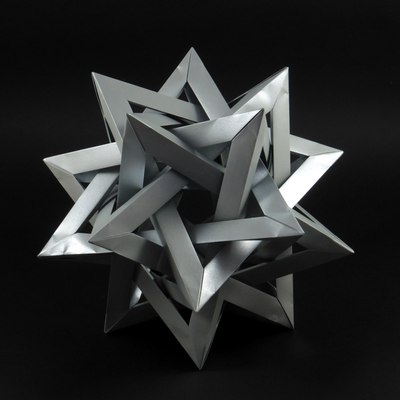
Five Intersecting Tetrahedra (FIT), designed by Thomas Hull, is probably the most popular model of the woven polyhedron type and an interesting mathematical object as well.
The author has prepared folding instructions, including diagrams for folding the units and information on assembling them, on the model’s web page. While folding the units is quite straightforward, joining them in the proper manner is not.
My tips for assembling the model

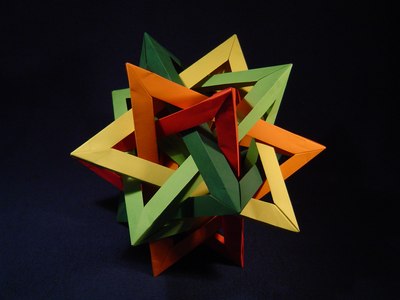
Original instructions for assembly are adequate, but not perfect. In this article I describe some rules and tips I came up with when assembling this model which can hopefully be useful to other folders as well.
If you already managed to fold the model once, the actual folded model is the best help you can get and much better than any flat pictures or diagrams. If you don’t have a folded model handy, you can use the pictures of the finished model found here as reference. The last few pictures are three-dimensional anaglyph images which can be viewed using red-cyan glasses to give an impression of 3D.
Before you proceed with reading my notes, I also need to mention another, very interesting method of assembly described by Dirk Eisner and based on ideas from Robert J. Lang and Francesco Mancini. This method is completely different from mine and it starts by creationg a 3D compound of four triangles (not tetrahedra). It’s certainly worth a try.
Spoiler warning: in my case, once I arrived at the rules described below, I was able to finish the model rather quickly. I recommend that you first try it all by yourself, following only the advice found on Tom Hull’s page and come back to the instructions below only if you can’t manage. Finding out the rules and the deep symmetry of this model are really fun even if it takes more time to finish the model that way.
- Two common colorings for this model are to either use five different colors, one for each tetrahedron, or to use a single color. I think the monochrome version looks more elegant, but if you are folding FIT for the first time, I recommend you start with the multi-colored version. Different colors really help to trace the different frames inside the tangled model and make it easier to find your way around.
- Start with two frames placed so that a vertex of one goes through the base of the other one and vice versa (“3D star of David”).
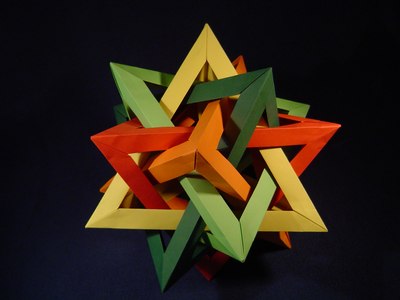
- Look directly at a vertex which goes through the base of the other tetrahedron (e.g. the vertex of the orange tetrahedron closest to the observer in the third image shown here).
- Now, you will have to weave three other tetrahedral frames around the base which consists of two frames. Have a look at the high symmetry of the three additional tetrahedra. One edge of each of them goes under one of the three visible edges of the orange tetrahedron. Two edges of each of these tetrahedra “surround” one edge of the orange tetrahedron placing that edge inside a “fork”.
- Once you manage to add the third frame (which is the hardest step in my opinion), the fourth and fifth are much easier because due to the high symmetry,
you can just copy the third frame, only rotated. Note that under the nearest visible vertex of the orange tetrahedron (and, symmetrically, under every other
vertex), three differently colored frames cross, forming a triangle similar to the inner part of the
Borromean rings. This structure is partially visible in the last image under the front vertex of the red frame.
- Alternatively, after you have assembled three tetrahedra, find the “knot” where three edges of three different tetrahedra are woven together and try to place a three-unit assembly over them. In the third image to the right, this would correspond to having connected the red, light green and dark green frames, and looking at them trying to place three connected orange units over them (and then adding the other three orange units in the back to close the frame).
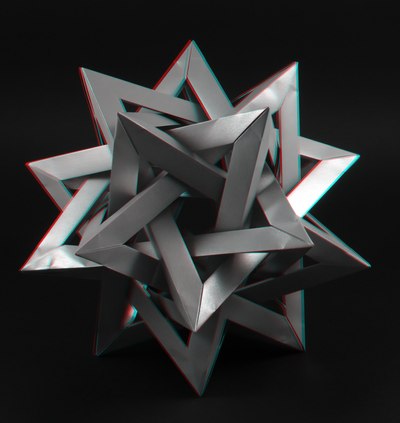

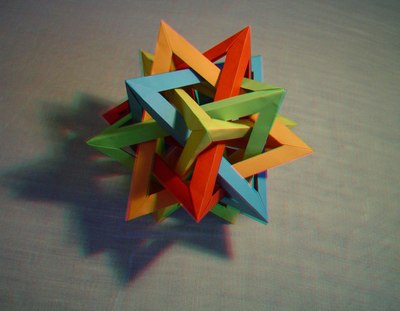

- Three-dimensional anaglyph images of this model can be quite helpful if you get confused.
- Note that the order in which colors appear in each of the pentagonal faces of the underlying dodecahedron is not the same for each face. So, for example, in the second image this order is (clockwise): orange, red, dark green, light green, yellow in the face visible in the front but it is different in some of the other faces.
- On Tom’s page, you will find a tip which says that the finished object has the property that any two tetrahedra are interwoven with one corner poking through
a hole of the other and vice versa. This is true and a very useful thing to watch, but keep in mind that this is a necessary condition but not a sufficient one.
That means that it is possible to start interweaving the frames and keeping the above condition while creating an intermediate model which will not allow you
to add more frames and create the desired finished model. For example, If you add the third frame in such a way that its same vertex pokes through two faces
of the two other tetrahedra, you will get a model which fulfills the criterion described above but which can’t be extended to create the final model.
In the correctly interwoven model, each vertex pokes through exactly one face of exactly one other tetrahedron. A more precise criterion (which I believe to be
sufficient) goes: any two tetrahedera A and B out of the five are arranged in such way that:
- One vertex of A pokes through one face of B and vice versa. Each tetrahedron has 4 vertices and each vertex pokes through exactly one face of exactly one other tetrahedron (a different one each).
- The face of A which is opposite to the vertex poking through B lies in a plane parallel to the plane of the face of B opposite to the vertex poking through A.
- Of the 4 faces of tetrahedron A, one is intersected by 3 edges of tetrahedron B (this is the face “poked-through” by B) and three others are intersected by exactly one edge of B each. There are 5 tetrahedrons altogether, and each has 4 faces. Looking at any single tetrahedron, one can say that each of its four faces is poked through by one vertex of a different neighbor. Checking this condition is a good test to see if your model’s OK at any given time — for example all arrangements where some face intersects with two edges of the same tetrahedron are deemed to fail.
- The frames are interwoven rather tightly. Even with only three of the five frames in place, the frames have very little freedom of movement. If you arrive at a partial model of more than two frames and the frames are loose, moving freely relative to each other, you have probably woven them incorrectly.
- Have fun! Putting this model together is somewhat mind-boggling and can be frustrating if you only want to finish it as fast as possible. It may take a lot of experimenting to find the right way of weaving the frames but it sure is worth the time.
Comments